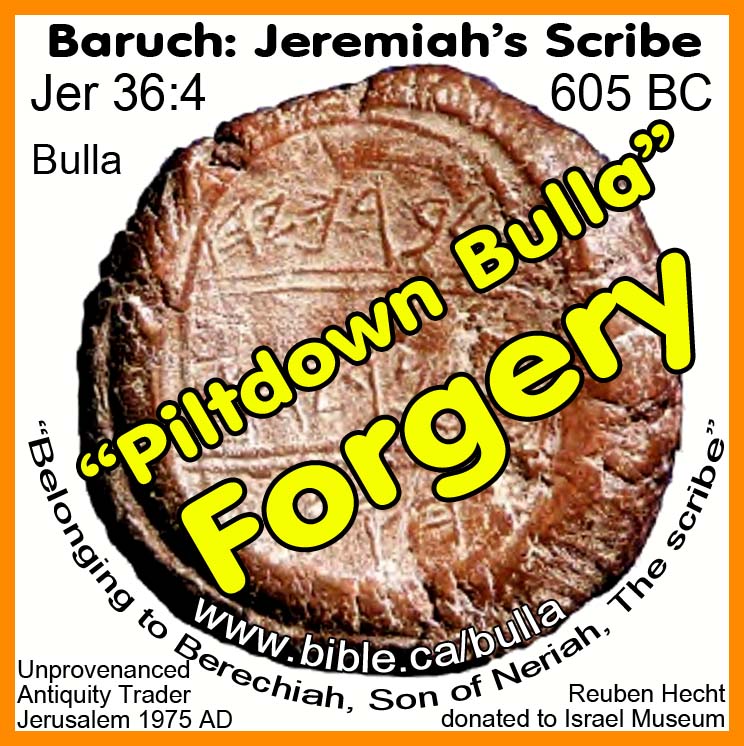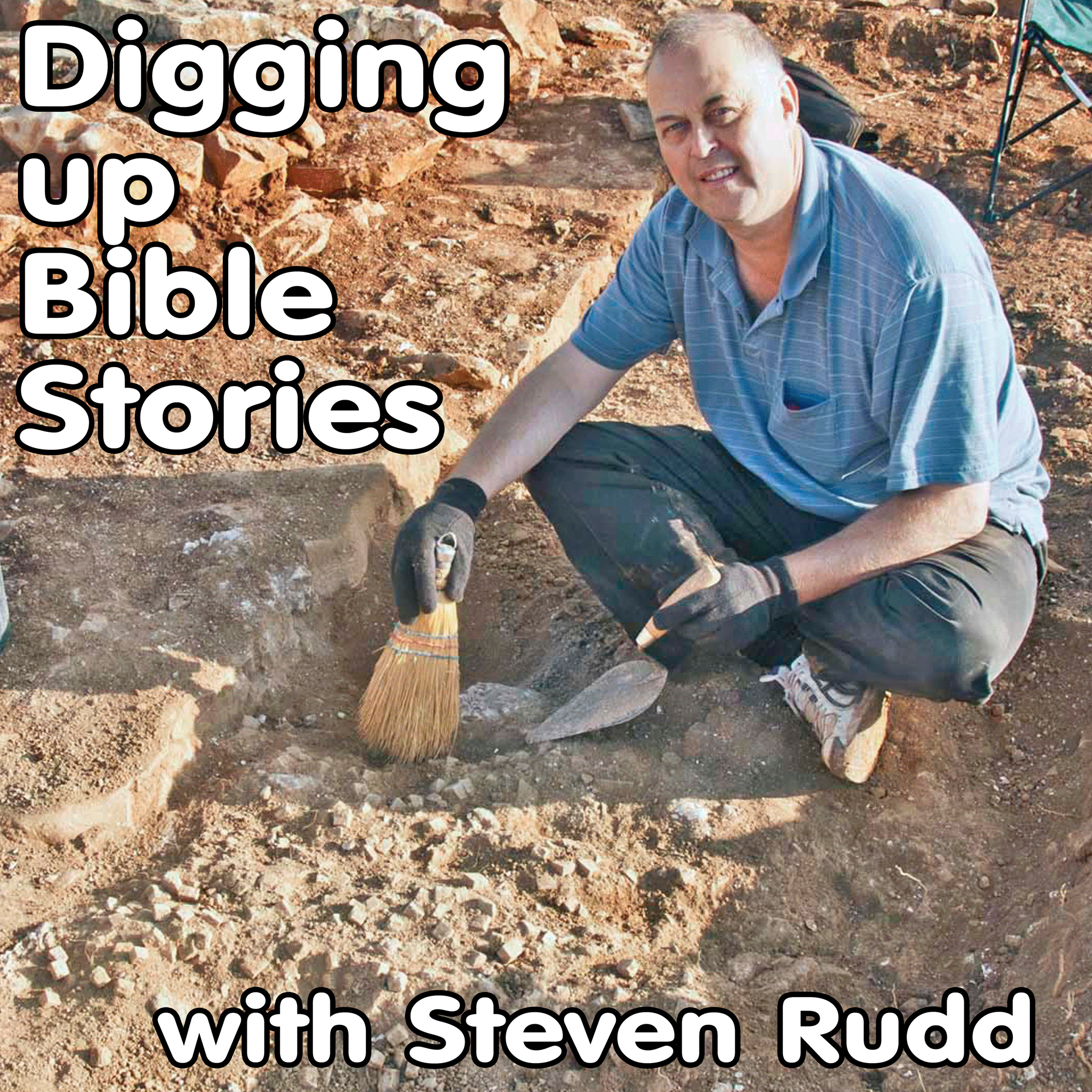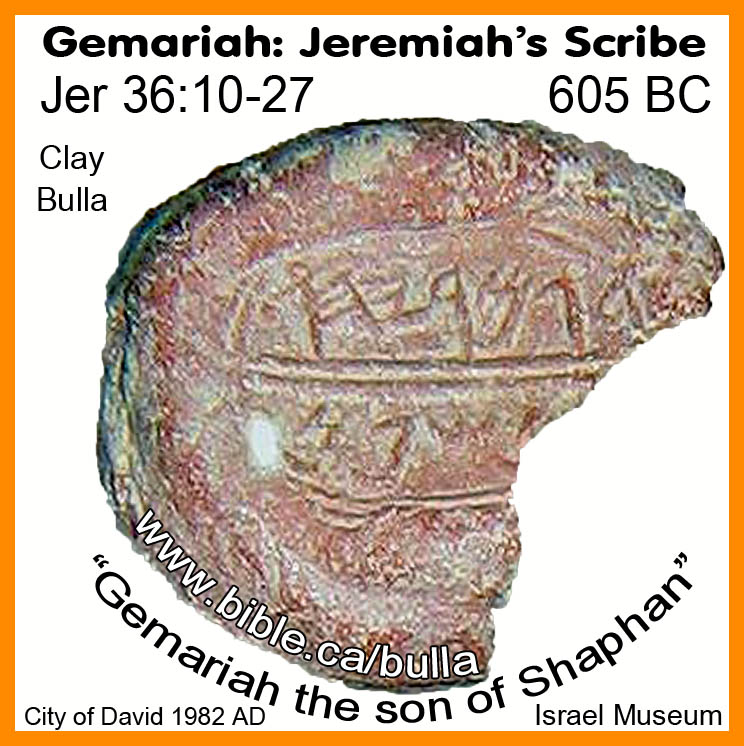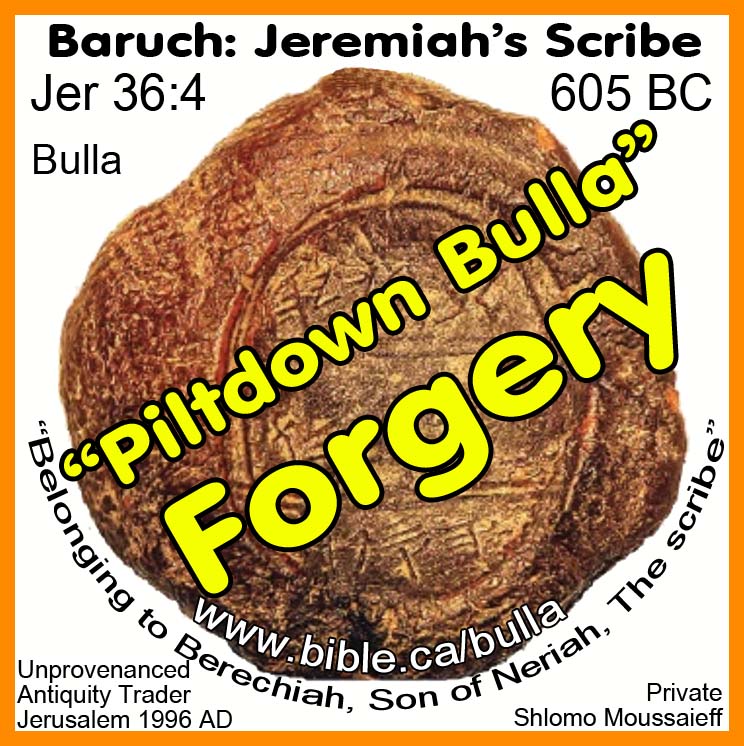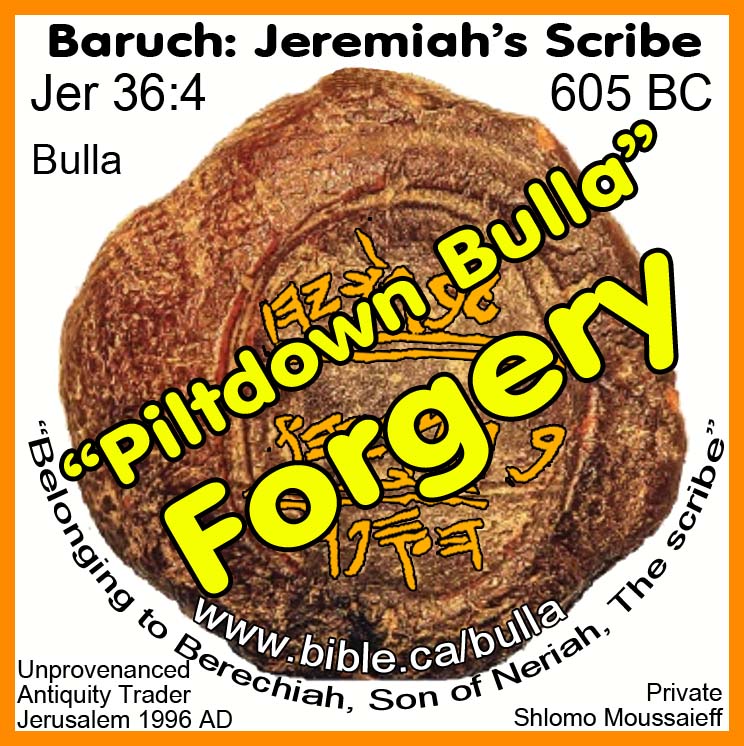Bulla of Baruch son of Neriah, Jeremiah's Scribe
FORGERIES, FAKES: Bible Bullae from Israel
|
Fake
Bulla of Baruch son of Neriah |
Piltdown Bulla: Known and suspected faked and forged bullae and seals
|
|
||||||
|
Encyclopedia of Bullae and Seals: FREE! The Exhibit: On-line Museum of Bulla and seals Security: Creation of ancient legal documents and the how bullae are made to seal papyrus paper. Forgeries: Known fake and misidentified bullae & seals |
||||||
|
|
||||||
|
Archaeologists are digging up bible stories!!! |
||||||
|
Archaeology is an important science that confirms the historical accuracy of the Bible. Since the Bible refers to hundreds of cities, kings, and places, we would expect to find evidence from on-site excavations. And this is exactly what we have found. The Bible is the most historically accurate book of history on earth. Read the Bible daily! |
|
|||||
|
|
||||||
Two Fake Bullae of Baruch, Jeremiah's scribe:
Catalogue of Faked, Forged and Misidentified Bullae and Seals of Judea and Israel
|
Jehoahaz, son of the king |
The Museum of Forgeries and Misidentifications of Bible Bulla and Seals from Israel and Judah |
Introduction: Piltdown bullae fooled the world's archeological experts for 40 years!
1. Like the "Piltdown Man Skull" forgery that fooled the world's top evolutionists for 40 years into wrongly thinking they had found Darwin's missing link until they tested it and found the bones had been treated with salts and the teeth were filed…. So too the bullae of Baruch the son of Neriah fooled the archeological world for exactly 40 years!!!
2. Baruch was an important person who assisted in the production of the Book of Jeremiah itself!
3. When king Jehoiakim burning the inspired scroll of Jeremiah, it was Baruch who replaced the copy of the scroll with a new papyrus script copy.
4. "Then Jeremiah called Baruch the son of Neriah, and Baruch wrote on a scroll at the dictation of Jeremiah all the words of the Lord which He had spoken to him." (Jeremiah 36:4)
5. "This bulla (now in the Israel Museum, the gift of Dr. R. Hecht, to whom I am obligated for permission to publish it), measuring 17 x 16 mm, is stamped with an oval seal, 13 x 11 mm. It has a single border line and is divided by horizontal double lines into three registers, all of which are inscribed. The script is the formal-cursive Hebrew of the 7th century BCE The samek in the bottom line has the typical cursive “tick” in the lower horizontal stroke. The unusual gap between the first two letters in the second line may have been caused by a defect in the stone of the seal. הספר (hspr) is the defective spelling of הסופר (hswpr), “the scribe,” an appellation which appears on various seals and which of course is employed frequently in the biblical corpus. One such “scribe” is Baruch Ben Neriah (Jer 36:4 and passim), with whom the owner of our bulla is to be identified. His full name appears to have been ברכיהו (berekyahu), Berechiah, as on the impression, a fact which was unknown before since the biblical accounts use the hypocoristicon ברו֡ (brwk), Baruch. For the sake of convenience, we shall use Baruch throughout the following discussion. In the Bible the name of Baruch’s father is rendered as either נריהו (nryhw) or נריה (nryh)." (Baruch the Scribe and Jerahmeel the King’s Son, Nahman Avigad, Biblical Archaeologist, 42, 1979 AD)
6. Christians don't need the Baruch bullae anyway since we already have a 100% certified Bulla of another scribe in Jeremiah: "Gemariah, son of Shaphan". (which is just as good at the Baruch bullae)
|
Gemariah: Jeremiah's scribe "Then Baruch read from the book the words of Jeremiah in the house of the LORD in the chamber of Gemariah the son of Shaphan the scribe, in the upper court, at the entry of the New Gate of the LORD’S house, to all the people." (Jeremiah 36:10) IAA legal excavation at City of David 1982 AD |
I. PILTDOWN BULLAE SPECIMIN EXIBITS: The two "Baruch son of Neriah" bullae are forgeries:
1. Baruch Bulla #1 of 1975 AD now in the Israel Museum
2. Baruch Bulla #2 of 1997 AD now in the private collection of Shlomo Moussaieff:
II. There are two different bullae of Baruch the son of Neriah from THE SAME FORGED SEAL.
1. Both bullae were impressed with the identical fake seal! The seal was pressed into two different lumps of clay.
2. Both bullae were NOT found in formal, official, controlled archeological digs but the BLACK MARKET of the Jerusalem Antiquity traders.
3. The first bulla was forged in 1975 AD and the second in 1996 AD.
4. Fingerprints, papyrus marks, and string indentations are seen on the back of both bullae.
III. About the BASOR article of 2014 AD:
1. For Bible believing Christians, reading the 2014 AD BASOR article, "The Authenticity of the Bullae of Berekhyahu Son of Neriyahu the Scribe", Yuval Goren, Eran Arie, BASOR 372, p147-58 was disappointing, depressing and infuriating!
2. The bullae are a top prize in Biblical archeology because it confirms the historical accuracy of the Bible, verifies the names as genuine and proves the Book of Jeremiah was written around the time of the Babylonian captivity in 587 BC.
3. After reading the article it was like learning chunk of gold you found is fools-gold and worthless.
4. But worse still, this was a deliberate effort to deceive for monetary profit by the forgers.
5. ABOUT THE AUTHORS: The paper from which the summary below came was written by Yuval Goren who works in the Department of Archaeology and Ancient Near Eastern Cultures, Tel Aviv University and Eran Arie who works at the Israel Museum in Jerusalem. (Steve Rudd)
IV. The scientific proof the two Baruch bullae are forgeries:
Summary of why the two Baruch bullae are forgeries when compared to genuine bullae from the article: "The Authenticity of the Bullae of Berekhyahu Son of Neriyahu the Scribe", Yuval Goren, Eran Arie, BASOR 372, 147-58, 2014 AD
1. THREE BULLAE PROVEN FORGERIES: In the introduction to their article Goren and Arie say: "For reasons explained below, we decided to add a third bulla, bearing the seal impression reading: lg’lyhw bn hmlk ([belonging] to Gealiyahu son of the King [Avigad 1986: no. 6, Israel Museum reg. no. IMJ 76.22.2301]), henceforth referred to as Gealiyahu 1."
2. LEGAL VS. ILLIGAL: Real bullae come from IAA Legally and professionally run excavations. While genuine bullae and seals do come from the Black market through illegal site looting, fake bullae always come from forger's basements. You simply cannot trust any bullae that come from any place other than controlled excavations. The Baruch bullae are an excellent case in point since they both came from the black market and are totally unprovenanced.
3.
OLD VS. WAXING OLD: The old appearance of real bullae is from three
thousand years of age. In both the Baruch bullae, a dark, wax-like polish that coats only the surface.
This is clearly evident by areas where small holes were drilled in the bullae
in order to perform TL (thermal luminescence) laboratory testing to determine
what kind of soil they were made of.
(pictured below is the 1975 AD Baruch bullae)
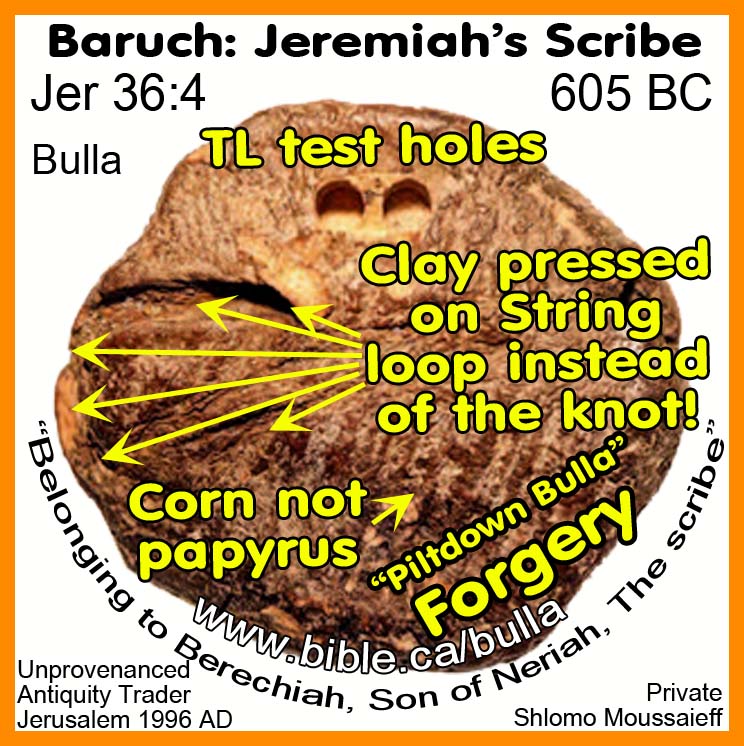
4. WRONG CLAY SOIL TYPE: All the genuine bullae from the official City of David dig were made of "Terra Rossa" clay soil. This has been determined by "thermal luminescence" (TL) testing. Both fake Baruch seals were made of clay from the "Moza Formation" not Terra Rossa soil. Moza is still used by potters in Israel but never for seals. This information was not scientifically available to the forgers until 2014.
5.
TWO VS. ONE KNOT IN THE STRING: Two
knots in the string were used instead of one because the whole point of a bulla
was security! You had to break the clay bullae to read the contents of the
document because one of the knots was in the middle of the bullae. In genuine
bullae, the string was tied and knotted around the legal document which was
first rolled, then flattened, then folded onto itself, then tied with a string
and knotted. On this first knot, a rectangular layer of clay is placed over it
on top of the document. Then the string is tied around the first lump of clay
and then a second knot ties the clay to the document, over which a second layer
of clay is pressed. The two layers are molded by fingers and the seal is
impressed and the clay is left to dry. Both of the
Baruch Bullae used a single clay lump
is pressed onto the LOOPS instead of the single knot tied to document. The
sting was insecurely pressed on bottom of clay only. Both Baruch bullae were
hanging at the end of a looped and partially unraveled twined cord which
penetrated them only partially, from the edge to slightly center the center of
the unstamped side. This made them very insecure and quite ridiculous! The
ancients would not be impressed!
See also: Creation
of ancient legal documents and the how bullae are made to seal papyrus paper.
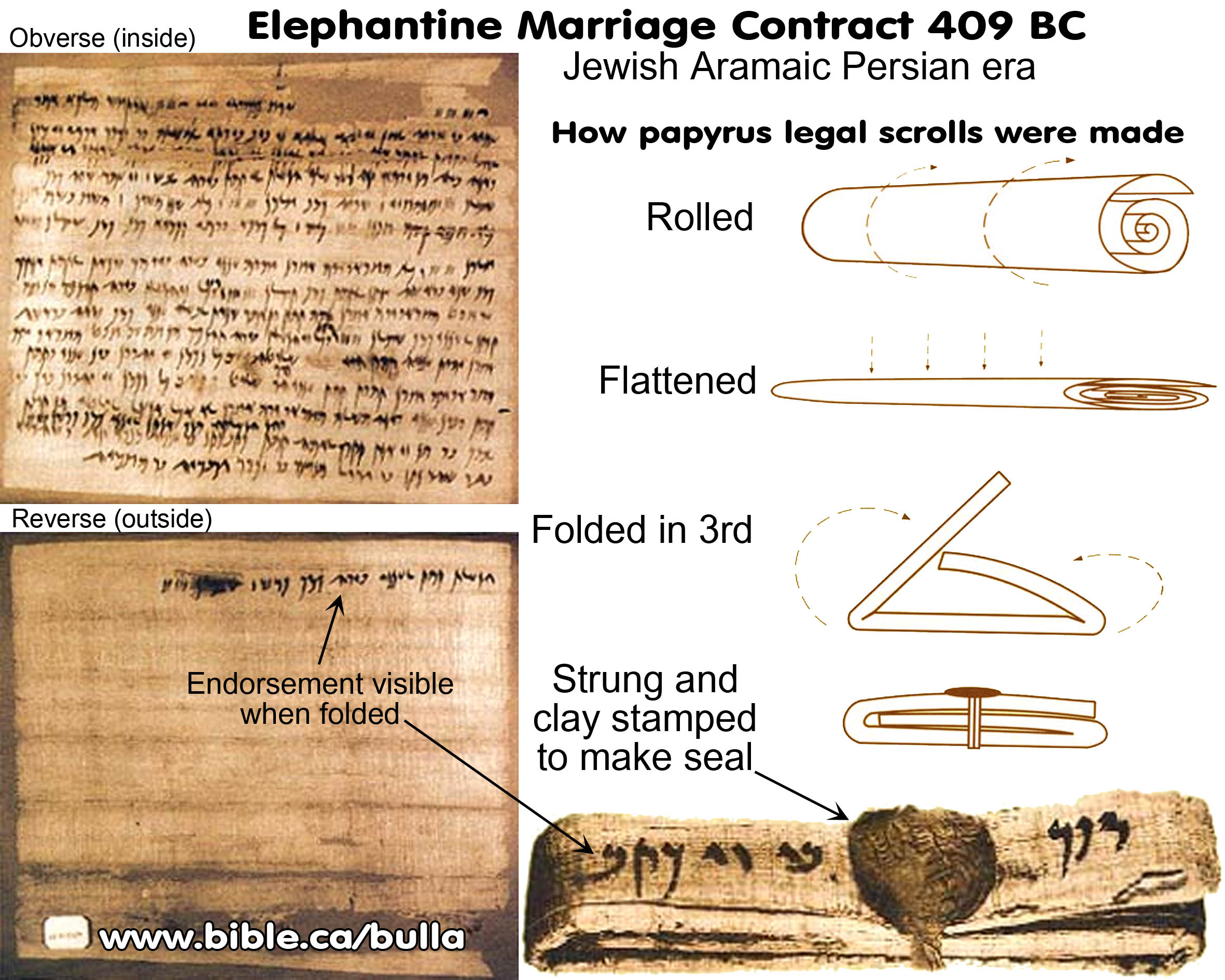
6. TWO GENUNE LUMPS VS. ONE FAKE LUMP OF CLAY: Genuine bullae are made from two different rectangular layers of clay placed on top of each other and pressed together to form a single lump. The reason for this was to put the string knot that wrapped around the legal document in-between the two layers of clay making it impossible to access the knot deep inside the bullae. "By using silty clay, which was often sealed when nearly “leather hard,” as evident from the cracks that many bullae have on their edges, clear impression could be achieved easily without the clay clinging to the seal. However, for this reason, the bulla could not be simply pasted over the papyrus and the cords, for which reason the two-layer method described above was required." (Goren, p155). The two Baruch bullae were made from a single lump of clay not two and since the string and single knot was on the outside of the clay, it was absolutely NOT SECURE. The scientific fact that all bullae made in 600 BC used a "two clay lump system" was not available to the forgers until 2014.
7.
KNOTS VS. LOOPS: In genuine bullae,
the clay is pressed onto the knots, in both Baruch bullae the clay was pressed
onto the loops of the knots of the string making them totally insecure. Think
of the way you tie your shoe. If you pinch the knot the shoe never comes undone
but if you simply pinch both loops, the shoe can easily be undone. The Baruch
bullae did not keep the document from being opened without detection. You could
remove the string from the bottom of the clay, read the document, then rewind
the string back onto the bulla without detection.
(pictured below is the 1975 AD Baruch
bullae)
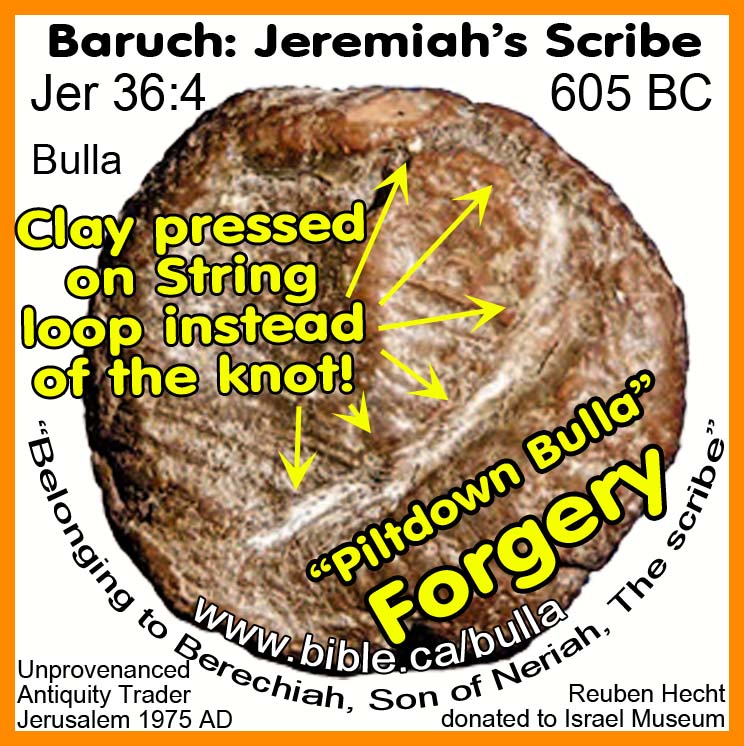
8. WRONG STRING: In genuine bullae, the string used to wrap the document is very delicate, but in the two Baruch bullae the String used was a crude, thick and clumsy cord.
9. TWO OF THESE THINGS ARE NOT LIKE THE OTHERS: Every bullae in the provenanced IAA Iron I and city of David excavations are made the same way which was very different from both Baruch bullae. "These [two Baruch] bullae are unique in that instead of being formed by the two-clay-layers method, they were created each from a single ball of clay that was applied around the last part of a thick cord, which was bent into a loop near its end. This phenomenon is completely absent in the eighth to sixth centuries b.c.e., when bulla formation was consistently based on the two-layer method. If this was done over a folded papyrus, it is difficult to comprehend how such a bulla could function to seal any document or how it could remain attached to it." (Goren, p154)
10. PAPYRUS VS. CORN LEAF: In real bullae, the papyrus impressions on the bottom of the bullae are a delicate mesh-type imprint of a common papyrus. In the two Baruch Bullae, the supposed "Papyrus impressions" on the bottom of the bullae are a coarse pattern of parallel grooves, similar to that of a corn leaf. (see photo above)
11. Genuine Calcitic patina vs sand and clue: In genuine bullae, calcitic patina is created in the Mediterranean subhumid climatic conditions that prevail in Judah from the precipitation of calcium carbonate in groundwater as the bullae go through hundreds of wet dry cycles over long periods of time. Glue-like substances never found on any bullae. In both Baruch bullae, laboratory tests show they are both coated with a whitish, calcareous-like gritty film of patina-like matter of a carbon substance indicative of a glue. In other words a fine white grit was glued to the fake bullae giving them the appearance of age.
12. FIRED WITH PETINA VS. UNFIRED WITHOUT PETINA: All the bullae in the City of David excavation were fully fired thanks to Nebuchadnezzar and have 3000 years of patina on them being buried in the ground. Unfired examples of genuine bullae from Lachish and Wadi ed-Daliyeh have no patina on them because the patina process destroys them. Only bullae fired past sintering stage can survive conditions that form patina on them. "While in theory such [a patina] coating can occur over the surface of a small unfired clay object, these processes should affect also the water-absorbing unfired clay, which would cause the object to crack and crumble. Hence, the presence of calcitic patina on an unfired bulla should result a priori in its destruction. … In contrast, most of the bullae from Jerusalem that we examined did have calcitic patina, but they were all found by our testing to be fired and well-sintered." (Goren, p156). Neither of the Baruch bullae were fired past "sintering stage" yet have heavy "patina". The only way these bullae would survive is if they were in a cool DRY place but this is contradicted by the patina layer which is formed in only in wet conditions! "Under these circumstances, the patina-like gritty calcitic material on the surfaces of Berekhyahu 1 and 2 and Gealiyahu 1 could not have been created under natural conditions on these unfired items in the Mediterranean subhumid climatic zones of Judah, including Jerusalem. The association of the gritty calcitic coating of the bullae with the glue may therefore be interpreted as an attempt to attach the powdered calcitic matter to the surface in order to replicate a patina-like process. While the contradiction between the unfired state of the clay and the presence of calcitic patina over it could not fool an expert, it could deceive a potential enthusiastic collector." (Goren, p157) This information was not scientifically available to the forgers until 2014.
13. CONCLUSION PILTDOWN BULLAE: The two bullae of Berekhyahu son of Neriyahu the scribe are modern creations, reflecting a series of technological misconceptions, anachronisms, and technological errors. Gealiyahu 1 is identical to them, most likely from the same forger’s hand. These technological misconceptions and technical errors represent the state of the research at the time when these counterfeits were revealed, sold to collectors, and published by academics. All these lines of evidence put together clearly point at modern creation. As mentioned by our colleague Christopher Rollston (in press) in another article tackling this issue, the present publication unfortunately may serve as an improved protocol for future forgers, whose work may become increasingly sophisticated. It is an unfortunate circumstance that these bogus artifacts could “star” for several decades in some of the scientific literature, in museum showcases, and in the popular literature, as emblems of Iron Age epigraphs. While many other bullae from the antiquities market that we examined, including some mentioning royal names (to be published elsewhere), were found to be authentic with great certainty, the Berekhyahu bullae raise again the problem of unprovenanced artifacts being published without any systematic and serious laboratory analysis. Of course, laboratories and archaeological scientists may be divided in their opinions, as has happened with many other biblical-era artifacts discussed recently by the media and elsewhere. But if there are serious doubts, the public should be made aware of them, and the scientific community should take extra measures to avoid the uncritical, irresponsible publication of fakes that results in the contamination of our history." (Goren p157)
Conclusion: PILTDOWN BULLAE
1. Our assessment is that until a peer-reviewed rebuttal is published we have labelled both Baruch bullae as FORGERIES.
2. The authors have the highest credentials in spite of any personal bias or agenda some may claim they have.
3. Given the overwhelming solid scientific evidence presented herein, we don’t expect one to ever be written and consider it a closed case.
4. Think about the chances of finding not one, but a second Baruch bullae from the same seal 21 years later. Given the high value Christians and archeologists placed on the first bullae which was universally held up as genuine… it seemed like a safe bet to forge a second one. Their greed made them rich, but now that we know the truth they are laughing at us all!
5. Christians say:
a. "IF ONLY IT WAS NOT A FRAUD AND FORGERY"
b. "I AM GOING TO WAIT TILL SOMEONE REBUTS IT"
c. It’s a forgery, get over it… let it go… it never was real… it was a deception of Satan… live and learn!!!
d. Christians have huge valid archeological evidence that prove the Bible historically and geographically accurate! READ MORE
6. Make my day and let me know when a rebuttal is written that refutes the science and removes the label of PILTDOWN BULLAE from these two "star bullae".
7. We have a 100% certified Bulla of another scribe in Jeremiah: "Gemariah, son of Shaphan" which is just as good at the Baruch bullae!
a. "Then Baruch read from the book the words of Jeremiah in the house of the LORD in the chamber of Gemariah the son of Shaphan the scribe, in the upper court, at the entry of the New Gate of the LORD’S house, to all the people." (Jeremiah 36:10)
|
Gemariah: Jeremiah's scribe IAA legal excavation at City of David 1982 AD |
See also: Creation of ancient legal documents and the how bullae are made to seal papyrus paper.
By Steve Rudd: Contact the author for comments, input or corrections.
